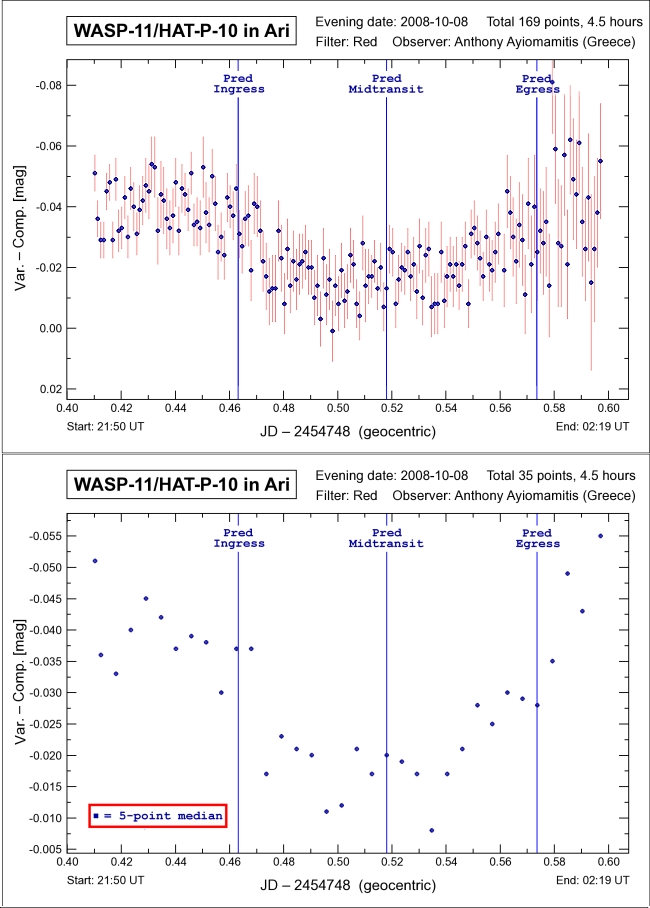
A variable star, as its name suggests, is a star whose magnitude varies intrinsically, in contrast to eclipsing binaries whose magnitude
varies as a result of one star in the binary system eclipsing the other. True variables are one of five types, namely Mira stars, semiregular
stars, cepheids, eruptive variables and, finally, cataclysmic variables. Minimum to maximum magnitude can range from days to many months with
some variables displaying irregular periods.
A popular method for the study of variable stars, particularly short-term variables, is by the use of the technique known as "differential
photometry". Rather than measure the (variable) magnitude of a variable star on an absolute scale, measurements are made over time relative
to one or more non-variable star(s) and these differences are then plotted so as to study and illustrate the relative or differential change
in magnitude. Due to the very large number of variables stars, the field of differential photometry represents one of the key fields in
astronomy whereby the amateur astronomer can make a meaningful and long-lasting contribution to both science and astronomy.
More recently, the search for extrasolar planets (over 275 discovered so far) has identified yet another interesting application for the
practice of differential photometry whereby the minute drops in magnitude of a star hosting an exoplanet are studied. Further details for the
interested party are available here.
Note: The light curve for exoplanet WASP-11b/HAT-P-10b in Aries depicted below is the latest (and least massive)
transitting exoplanet discovered to-date, having being announced in Sept/2008, and represents the eleventh discovery by the WASP (Wide Angle
Search for Planets) team and tenth discovery by the Hungarian-based HATNet Project team. WASP-11b/HAT-P-10b is characterized with a light mass
of only 0.46 that of Jupiter while its radius is equivalent to 1.05 Jupiter radii, thus making this exoplanet one of the least dense and
certainly least massive exoplanet discoveries to-date. WASP-11b/HAT-P-10b requires 153 minutes to transit its parent star at a depth of 20
mmag (or 2.0%). The parent star, GSC 2340:1714, is a K3V dwarf star estimated to have a mass of 0.82 solar masses, a radius equivalent to 0.81
solar radii, a temperature of only 4,980° K and to lie at a distance of 408 light-years away with a visual magnitude of 11.89. Further details
regarding WASP-11/HAT-P-10 and WASP-11b/HAT-P-10b are available in the papers published simultaneously by the discovery teams led by Richard
West et al (click here) and Gaspar Bakos et al
(click here).
Note: The C- and K-stars used for the purposes of the differential photometry measurements depicted below were
GSC 2339:1086 (mag 11.9) and GSC 2339:1503 (mag 11.9) respectively. The light curve below is the first amateur
result of this newly discovered exoplanet in the constellation of Aries.
|
Parent Star: WASP-11/HAT-P-10 GSC/SAO Catalog: GSC 2340:1714 Constellation: Aries RA / Dec: 03h 09m 28.54s / +30° 40' 26" Magnitude: 11.89 Distance: 408 light-years Exoplanet: WASP-11b/HAT-P-10b Period: 3.722469 + 0.0000067 d Transit Duration: 153 mins Transit Depth: 20 mmag Minimum Mass: 0.460 MJup Radius: 1.045 RJup Pred Transit Details:
|
 |
Date: Oct 09, 2008 00:50:02 - 05:20:34 UT+3 Location: Athens, Greece Equipment: AP 160 f/7.5 Starfire EDF AP 1200GTO GEM SBIG ST-10XME SBIG CFW-8A Astrodon Tru-Bal CRGB Integrations:
Temperatures:
Software: CCDSoft V5.00.188 AIP4Win V2.2 Processing: Reduction Differential Photometry |